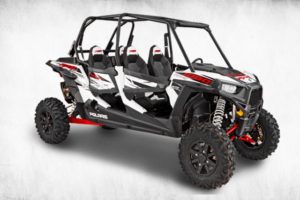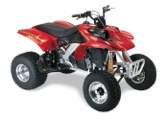SRN recently heard from Carma McKinnon, Idaho’s CPS coordinator located at Lemhi County Sheriff’s Department, regarding concerns over ATVs and UTVs. ATVs (all-terrain vehicles, aka quads) and UTVs (utility-task vehicles, aka side-by-sides, recreational off-road vehicles, or ROVs) are used by families across the country for both recreation and work purposes, but can be extremely dangerous to children.
McKinnon noted that ATVs and UTVs are very popular in her state, and this seems to be the case across the country, with the largest sales volumes found in rural areas, especially in the South and Midwest. Sales have grown substantially over the past 10 years. Based on data from the Motorcycle Industry Council and the Specialty Equipment Market Association, roughly 250,000 ATVs are sold in the U.S. each year. Sales of UTVs have been even hotter; this newer market entry has surpassed ATVs in sales, with around 400,000 currently sold per year. Sales of these vehicles fluctuate with the strength of the economy, so they may vary widely from year to year.
ATVs and UTVs: What’s the Difference?
Both ATVs and UTVs have four wheels, go to speeds that can exceed 65 mph, and are made for off-road use. Otherwise, they’re quite different in many ways.
UTVs are made for off-road work and fun. But, despite having seat belts, they are not safe for kids—including ones in CRs! Both UTVs and ATVs can pose serious risks to children under many circumstances.
ATVs are typically one-person vehicles. The driver straddles an ATV, sitting like a motorcycle rider and using handlebars to steer
UTVs, on the other hand, have seats more like a car, and the driver sits upright and steers using a steering wheel. These vehicles have seats that are side by side for a driver and passenger, and some even have back seats for up to five total occupants.
Another important difference: UTVs have such safety features as a roll bar and lap-shoulder belts for each seating position, whereas ATVs do not.
Despite their many differences, both types of vehicles have a high “cool factor” that has a strong appeal for both young and old. They can be employed for practical purposes, especially for people with large pieces of property, but both are also very popular for recreation, racing, and extreme sports.
Why are ATVs and UTVs so Dangerous?
A variety of factors make both ATVs and UTVs dangerous, especially for kids. Both types of vehicles are used on uneven terrain, provide little to no protection for passengers, and are often used in ways that are contrary to recommendations. Allowing children to drive heavy, powerful machines made for adults, carrying passengers on one-person vehicles, and failing to wear a helmet are common problems.
And, although riding on extreme terrain is sometimes a problem, an even more common risk factor, surprisingly, is using these off-road vehicles on paved surfaces. Off-road vehicles are inherently prone to tipping over, and their low-pressure tires do not grip paved road surfaces properly. In addition, features like lighting and turn signals that are important for safely sharing roads with other vehicles are usually not present on off-road vehicles. Despite this, the laws of most states do not prohibit ATV/UTV use on public roads, and many actually allow their use on some highways. (To learn more about laws by state, go to the National Conference of State Legislatures website and search ATV.)
ATVs and UTVs fall outside of NHTSA’s authority and are instead overseen by the Consumer Product Safety Commission (CPSC). Gathering statistics on deaths and injuries due to these vehicles is challenging, but the CPSC estimates that, in 2014, 93,700 patients were treated in emergency rooms for injuries involving ATVs, and that 26 percent of these were children under 16 years old. Of 626 ATV-related fatalities in 2011 (the most recent year for which such data is complete), 81 were children younger than 16. The relatively recent introduction of UTVs further complicates data collection, and though the CPSC has begun to collect information on UTV incidents, official statistics have not been posted.
Off-Road Vehicle Safety Recommendations
Special training is recommended for ATV/UTV drivers, since there is much to learn to safely operate these vehicles. Although there is much more to know, the CPSC recommends these basic safety precautions when using ATVs and UTVs:* ((Information on the CPSC website refers to UTVs as recreational off-road vehicles, or ROVs. Although UTV seems to be the more common term, the terminology is far from standardized at this point. Many manufacturers seem to favor the term “side-by-side” or “SXS.”))
- Don’t drive either of these off-road vehicles on paved roads.
- All drivers and passengers should wear a helmet, as well as other protective gear like eye protection, gloves, and clothing that covers the body.
- The number of occupants shouldn’t exceed the number of seats; for ATVs, this means no passengers.
- Drivers should take a hands-on safety training course.
- Children under 16 should not drive a UTV or adult ATV.
- Further precautions specifically for UTVs:
- Always fasten the safety belt.
- Keep all body parts inside the vehicle.
- Never carry passengers in the cargo area.
- Be sure all passengers are large enough so that both feet rest on the floorboard while their back is against the seatback. (Editor’s note: That means no kids of CR or booster age!)
What Do CPSTs Need to Know?
When McKinnon contacted SRN, she was trying to locate sources of official guidance to limit the exposure of small children to the risks of ATVs and UTVs.
In general, tell families about the safety guidelines, above; more details are available online at the CPSC (click on Safety Education Centers under the Safety Education tab). Also advise them to consult the vehicle instructions and local laws and safety guidelines, which can be found through such state sites as the forestry service, parks and recreation department, and/or department of licensing. Law enforcement agencies and/or the prosecuting attorney’s office can also provide helpful advice for interpreting local statutes.
But what does a CPST say to a family who wants advice or assistance installing a CR on a UTV, which has seat belts? McKinnon reported that it was not uncommon for the presence of seat belts on these vehicles to lead some families to the idea to install a CR for young children (despite manufacturers advice that all occupants be tall enough to place their feet on the floorboard). In fact, a simple search of enthusiast forums uncovers many people who freely offer this advice, and many photos are posted online that feature children riding in CRs on UTVs.
In Idaho, wording of the state’s child occupant protection law would even seem to require CR use, as it states that children under age 7 “in a motor vehicle manufactured with seat belts” must ride in a CR.
But, if you ask CR manufacturers’ reps about this, they will be clear: Off-road vehicles do not come close to meeting NHTSA’s definition of “passenger car” or “multipurpose passenger vehicle,” so they are not approved for CR use.
Currently, the Manufacturers Alliance for CPS (MACPS) includes among its harmonized statements one that prohibits CR installation in low-speed vehicles, and with the growing popularity of UTVs, this group recognizes the need to amend that statement to add these non-low-speed but equally non-approved vehicles. An update to this statement is likely to be released later in the summer, and SRN will run an article when and if this occurs.
Even without a statement that specifically mentions UTVs, a careful reading of the CR owner’s manual can sometimes be helpful. For instance, Evenflo instructions say the CR is “certified for use only in passenger and multi-purpose passenger motor vehicles, buses, and trucks equipped with Type I (lap-only) or II (lap-shoulder) seat belts and in aircraft.” While the average caregiver may not recognize that these terms refer to official NHTSA vehicle designations (which do not include off-road vehicles), a CPST can explain this to them.
But short of getting this in writing from the MACPS or from the CR manufacturer, no other authority has yet stepped up to address the issue of CRs on UTVs. McKinnon observed that instructions prohibiting CR use on UTVs should be a requirement in the UTV instructions and on labeling, and SRN agrees. The CPSC is the agency that would have authority to impose such requirements on the UTV industry; learn about CPSC standards and voluntary standards, and how to file a petition, at www.cpsc.gov (look under Regulations, Laws, and Standards).
Resources:
Consumer Product Safety Commission (CPSC): Click on Safety Education Centers under the Safety Education tab.
National Conference of State Legislatures (NCSL): Find ATV-related laws by state, a report on dangers of use on paved roads, and other information on their website (search ATV).


